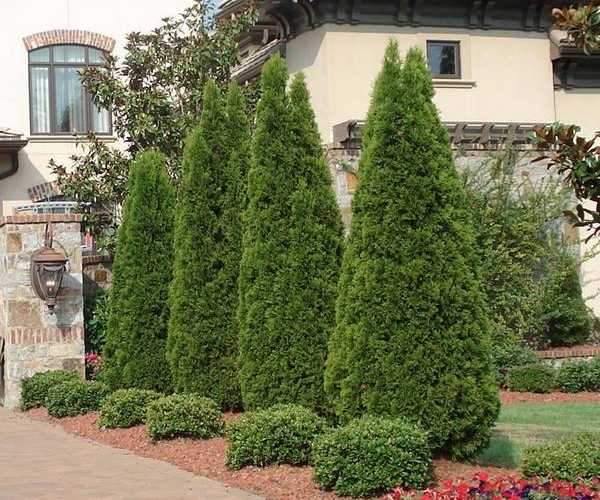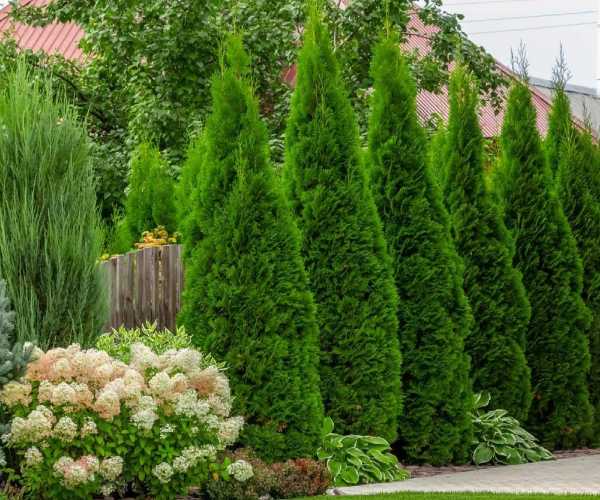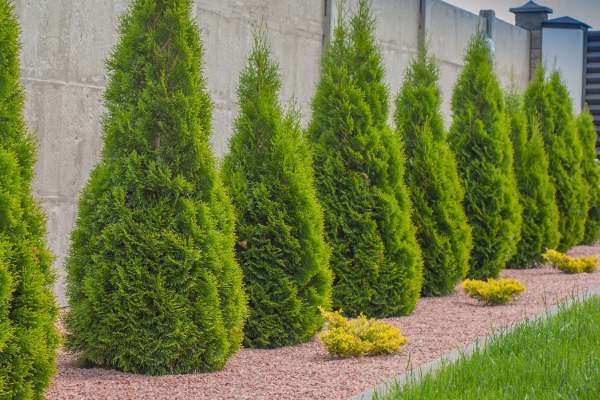Emerald Green Arborvitae (Thuja occidentalis ‘Emerald Green’) are popular evergreen shrubs known for their dense, emerald-green foliage. These low-maintenance evergreen trees are great for hedges, privacy walls, or accent trees. They grow quickly up to 20 feet tall and are resistant to cold weather and pests. Arborvitae are best planted in the fall and their foliage is a vibrant green with reddish-brown cones. Although they require minimal care, it is important to note that they are toxic to humans and animals.
Here are some more basic information about Emerald green arborvitae:
| Common Name | Emerald green arborvitae, Smaragd arborvitae, American arborvitae, white cedar |
| Botanical Name | Thuja occidentalis |
| Family | Cupressaceae |
| Plant Type | Tree |
| Mature Size | 12–20 ft. tall, 3–10 ft. wide |
| Sun Exposure | Full, partial |
| Soil Type | Moist but well-drained |
| Soil pH | Acidic, alkaline |
| Hardiness Zones | 2–7 (USDA) |
| Native Area | North America |
| Toxicity | Toxic to people and toxic to pets |
Light
Emerald Green Arborvitae thrive in full sun to partial shade. They require at least six hours of sunlight daily, but excessive direct sunlight can harm the plant. However, they should also avoid full shade as it can negatively impact the density of their foliage
Soil
Emerald Green Arborvitae prefer soil that is moist but well-drained and has a neutral to alkaline pH level. Avoid overwatering, as their roots do not like to sit in soggy soil. To help retain soil moisture, apply a thick layer of compost or mulch around the base of the plant each year. By following a regular watering schedule, the mulch will help to maintain soil moisture.

Also, Read These are the Best Companion Plants for Roses!
Water
New arborvitae need more frequent watering. During the first few months after planting, water your arborvitae twice a week. After about a year, reduce watering to once a week, ensuring it receives around 1 inch of water. Once established, it will need about half an inch of water per week, which can come from rain or irrigation.
Temperature and Humidity
Emerald Green Arborvitae thrive in cooler, drier climates. In humid areas, fungal diseases can be a problem. To prevent this, plant the trees at least 3 to 4 feet apart to increase air circulation. Avoid planting them in exposed, windy locations, especially in colder climates.
Fertilizer
Arborvitae plants generally don’t require fertilizer. However, if you notice that the new growth is very thin or slow, you can use a balanced fertilizer that contains all the essential nutrients. Follow the instructions on the fertilizer packaging for the correct amount to apply.
Planting Emerald Green Arborvitae
When to Plant
Fall is the best time for planting arborvitae as it allows their roots to be established before winter arrives, minimizing heat stress.
Where to Plant
- Choose a spot with moderately moist, well-drained soil in full sun or partial shade (especially in warmer climates).
- If planting for a privacy fence or screen, leave 3-4 feet between each tree.
How to Plant
- Prepare the Root Ball: Remove the burlap wrapping or gently loosen the roots from the container.
- Dig a Hole: Create a planting hole twice as wide and deep as the root ball.
- Position the Arborvitae: Keep the root ball in the hole, ensuring the top edge is level with the surface.
- Backfill and Water: Fill in the hole with fresh soil, watering thoroughly halfway through. Pack down the soil with your hands.
- Finish Planting: Complete filling the hole and water thoroughly again.
- Add Mulch: Apply a 2-inch layer of mulch around the base, avoiding contact with the stem.
By following these steps, you’ll ensure a healthy start for your Emerald Green Arborvitae.
Pruning Emerald Green Arborvitae
Light pruning in early spring can help maintain the shape of your arborvitae and encourage denser growth. Here’s how you can do it:
- Target Leafy Parts: Trim the leafy portions of the branches, avoiding cutting back to bare wood.
- Remove Dead or Diseased Branches: Prune away any dead or diseased branches to prevent decay and improve air circulation.
- Maintain Natural Shape: To preserve the natural, wider-at-the-bottom tapering shape, prune accordingly.
- Create Topiaries: For more adventurous gardeners, spiral topiaries can be formed through careful pruning.
Remember, pruning should be done lightly to avoid damaging the plant. If you’re unsure about pruning techniques, consulting a professional arborist would be the best idea.
Overwintering
Arborvitae are cold-hardy but can benefit from extra winter care, especially when young. Snow and ice can cause stem breakage. Periods of drought, high wind, and plunging temperatures can cause drying out and browning. Mulch can also keep the roots insulated and retain moisture in the ground.

- Snow and Ice: Brush off heavy snow and ice to prevent stem breakage.
- Drought and Wind: Protect against drying out and browning caused by drought, high wind, and plunging temperatures.
- Mulching: Apply a layer of mulch to insulate the roots and retain soil moisture.
- Stem Protection: Tie stems with twine or wrap them in burlap around a circle of stakes, especially if you live in zone 2, to protect against hungry deer.
By following these tips, you can ensure your arborvitae stays healthy and vibrant throughout the winter.
Common Pests and Diseases Affecting Arborvitae
While arborvitae are generally resistant to pests and diseases, a few issues may arise:
Bagworms: These caterpillars feed on the foliage, creating unsightly bags. Manually remove and destroy the egg bags before they hatch.
Spider Mites: Tiny spider mites can infest arborvitae, causing yellowing and browning of the foliage. Treat them with insecticidal soap or a specialized mite control product.
Needle and Twig Blight: This fungal disease can affect arborvitae, especially in conditions with poor air circulation. Prune off affected branches and apply a fungicide.
Stem Canker: A serious fungal disease causing lesions, sores, and sticky resin. Remove affected branches immediately. If the trunk is affected, the tree may not survive for a long time.
Regular inspection of your arborvitae will help you identify and address any potential problems early on. That is one best way to take care of your plant.
Common Problems with Emerald Green Arborvitae
While Emerald Green Arborvitae are generally hardy and low-maintenance, some common issues may arise:
Browning Leaves in Winter
- Natural Color Change: Some browning is normal during winter, especially if temperatures drop suddenly or there’s insufficient moisture.
- Watering: Ensure the plant receives adequate water, especially if the soil dries out or there’s no rain or snow.
Dropping Needles
- Natural Shedding: Arborvitae naturally shed needles from their interior each year.
- Cleaning: Remove the fallen needles to prevent rot from spreading to the other parts of the plant.
Loss of Foliage from Top Down
- Bagworms: These caterpillars defoliate arborvitae, starting from the top. Remove egg bags and consider using neem oil or a pesticide for severe infestations. If not checked in time, it can damage the whole plant.
By addressing these potential threats, you can maintain the health and beauty of your Emerald Green Arborvitae.
Faqs
1. How fast does emerald green arborvitae grow?
Emerald Green Arborvitae grow at a moderate pace. When young, they can grow 1 to 2 feet per year. However, as they mature, their growth rate slows down to about 6 inches per year until they reach their full height.
2. Are there any downsides to planting arborvitae?
Arborvitae are generally low-maintenance trees, but one potential issue is their susceptibility to breakage. They can easily split or break, especially in heavy wind or under the weight of snow. If this happens, it’s important to prune off the broken branches and stake the tree until it recovers.
Another concern is bagworms. These pests can infest arborvitae, causing damage to the foliage. Regular inspection and removal of bagworm sacs can help prevent infestations.
3. What is the difference between emerald green arborvitae and “Green Giant” Arborvitae?
“Green Giant” arborvitae is known for its rapid growth, adding up to 3 feet per year. However, Emerald Green arborvitae, while growing more slowly, is generally considered more cold-hardy and can tolerate colder climates better.
4. How long can emerald green arborvitae live?
The lifespan of an Emerald Green Arborvitae can vary significantly, ranging from 25 years to 150 years. Several factors influence its longevity:
- Climate: Arborvitae thrives in cooler, temperate climates. Harsh winters or extreme heat can shorten their lifespan.
- Soil Conditions: Well-drained, nutrient-rich soil promotes healthy growth and longevity. Poor soil quality can limit the tree’s lifespan.
- Care and Maintenance: Proper care, including regular watering, fertilization, and pruning, can extend the life of an arborvitae. Neglect or improper care can lead to premature decline.
- Pests and Diseases: Arborvitae are generally resistant to pests and diseases, but severe infestations or fungal infections can weaken the tree and shorten its lifespan.
Also, Read Common Mistakes Growing Papyrus Plants and How to Fix Them
